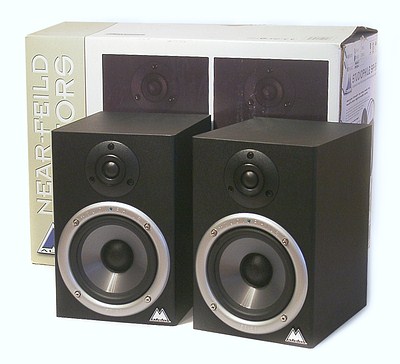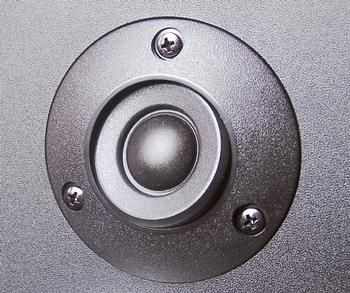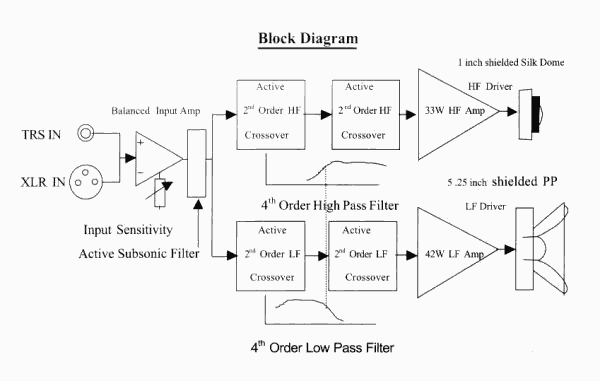 |
||
|
||
| ||
You probably know quite well the difference between studio monitors and other acoustic systems. The monitors has realistic and true sounding. First of all, it is necessary in studios for processing musical material. Today we will examine Studiophile SP-5B active near-field monitors from Midiman. Our readers know this manufacturer thanks to a successful (inexpensive and high-quality) professional M-Audio Audiophile 2496 sound card. This time Midiman, owner of the M-Audio trade mark, attracts our attention with another interesting solution. The Studiophile SP-5B model has quite a moderate price (less than $500 for a pair), small dimensions, separate amplification and connection of HF and LF heads (bi-amping and bi-wiring), quality sounding and original construction of tweeters. Later we will go into details.  M-Audio Studiophile SP-5B Active Near-Field Monitors The SP-5B monitors sell in a beautiful box of a design standard for products of the M-Audio mark: there is a vertical stripe with the name on the left and a photo of the product on the right. The box contains two active speakers, cables and a brief user manual. Now let's turn to the technical characteristics of the Studiophile SP-5B Near-Field Monitors.
You won't face problem of finding space when arranging these monitors on the table, because their dimensions are not great. Note that they should be directed toward a point a listener's head is in. It is desired that this point forms an equilateral triangle together with the monitors. The axis of each high-frequency speaker must be aimed at his ears. All this is necessary in sound processing for more precise determination of flaws and inaccuracy for their further elimination.  M-Audio Studiophile SP-5B monitors next to a 17" display Here I'd like to tell you about an interesting swivel mounting construction of the HF speaker (tweeter). The high-frequency head is put into a hermetic case which turns by 20 degrees in each direction.  Original swivel mounting of the HF speaker (tweeter) The construction itself doesn't worsen sound and is a pleasant bonus which solves the problem of precise aiming of the tweeters at the listener's ears. Now you don't have to adjust height of the stands and an orientation angle of the whole speaker. You just have to turn the HF speaker and that's all. The HF speaker of the monitors doesn't actually have a pronounced directional diagram, that is why it's not necessary that the tweeters were precisely oriented. But we liked that possibility very much. Maybe efficiency of such engineering solution is not so great, the fact that the HF speakers are directed correctly and amplitude-frequency distortions are minimized pleases me.  Special molded loudspeaker cone's surface improves rigidity and reduces distortions in the transition zone The MF speaker is also very interesting. The case of the loudspeaker's cone is made of molded material which reminds me of thin-wire spring glued to paper. The corrugation is made of soft rubber. The MF speaker's cone is encompassed by a metallic hoop, which is probably just a designer's add-on. Its upper part has a power indicator of purple color. The cases are certainly made of wood (or rather, MDF). The panels are 16 mm wide. For speakers of such dimensions such width is normal. The only small downside of the monitors is that the phase-inverter's holes are located on the back. That is why you can't place the speakers tightly to the wall - the distance from the nearest vertical obstacle mustn't be less than 20 cm. But this is just a moderate cost of small dimensions and functionality of the monitors.  The rear panels of the speakers look completely identical The rear panel is standard: power connector (separate for each speaker), power switch, volume control and two line-ins. The speakers can be connected either through XLR (only balanced connection) or TRS (balanced and unbalanced connection possible). The specified input sensitivity is 200 mV. It allows connecting sources even with an untypically weak level of a linear signal. If you a computer musician the best way to connect the studio monitors to your PC is through a hardware audio mixer. The block diagram provided by the manufacturer shows a two-way amplifier with a 4th-order crossover. A level controller and a subsonic filter are located on the input.  Block Diagram of the two-way amplifier of one of the speakers (Such amplification circuit is also used in other high-quality studio monitors, for example, in twice more expensive Event 20/20 bas which are constantly used in our audio test lab). Subjective tests: listening and comparison with the Event 20/20 basFor listening to the Studiophile SP-5B monitors we took a professional ESI Waveterminal 2496 soundcard which is usually used as a reference one in all our tests. The unbalanced connection was established directly from the card to the monitors, by using the Proel professional microphone cables, with the rated gold-plated Proel TRS connectors. Sound quality was estimated by comparing it to the near-field studio monitors Event 20/20 bas. This acoustic system (the top model of the Event's monitor line) is considered by some specialits as a reference one in the sub-$1,000 category. In general, the sound is really great. I can't even believe that the sound is produced by exactly these speakers, and not twice dearer Event 20/20 models standing next to them. It's unusual that the speakers of such size as Studiophile SP-5B can play so excellently. During the tests I didn't find any considerable flaws in the sound they were producing, despite our faultfinding listening. Even at a high volume level the monitors did not produce any additional noises and distortions. As I mentioned before, the swivel mounting of the HF head is really justified. Now a little on peculiarities of sounding of this model. The MF speaker plays a little more "compressed", it focuses on middle frequencies (it underlines them, not overstresses). Thanks to good sensitivity of the speakers it's possible to work even at a low volume level. It is very important for a home studio. The lowest audible LF range is almost lacking, but there are no distortions either. And this is a merit of the subsonic filter on the input. In comparison to different Hi-Fi speakers close in dimensions which make miserable attempts to produce deep bass, the tested monitors play honestly and produce only that frequency range which is possible taking into account their dimensions. Therefore, the power is not lost, and the sound is clear and accented, with no additional sounds. This is exactly what a monitoring acoustic system needs. In the bass forming the phase inverter helps the monitors much. Low frequencies are not so deep as compared with the Event system, but their sound is still rather pleasant. After that we carried out an exclusive test by trying the monitors in real conditions. After downmixing 9 audiotracks in Cubase 5.1R1 (test.mp3, 634 KBytes) on the Studiophile SP-5B monitors we listened to the final PCM wav-file on the Event 20/20 bas system. We did it to find out where the SP-5B can let us down. The test showed that there were some small flaws only in adjusting the timbre of the bass guitar (VST-instument VirtualBass). On the Event the bass part sounded with timbre and character a little different from what had been planned. However, it is a usual work for studios to listen to compositions on different acoustic systems - from the most expensive floor solutions to cheap portable boom boxes and even computer speakers. So, for producing music compositions in electronic modern dance styles in home/project studios the Studiophile SP-5B speakers are an excellent choice. But classical music and jazz should be monitored during recording and then combined on something more expensive. However, the tested monitors do not pretend to such tasks. But they excellently cope with those they are meant for. Objective tests: Frequency Responce and Distortions measurementsThe measurements were carried with the RMAA AE 3.4 program which is developed by us. Signal is generated by the professional sound card ESI Waveterminal 2496 with an unevenness of -0.01/+0.07 dB of the frequency-vs-amplitude response. The measurements were made with the special measurement microphone Behringer ECM8000.  FR and THD diagrams of the Studiophile SP-5B near-field monitors Look at the diagrams above. In the whole working range the frequency response looks like a smooth line, without sharp peaks or dips. And this is very significant. The distortion level is also perfect - it never exceeds 1% (-40 dB). Note that there are no dips on the graph in the meeting point of frequency responces of the LF and MF speakers. The graph in this frequency range is even, and the distortion level is not high (no more than -40 dB or 1%), which means again that the crossover is designed perfectly.  FR diagram from the specification of the Studiophile SP-5B
monitors It is very possible that the manufacturer tested the monitors with "pink noise" test signal. Contrary to the "swept sine" that we used, this approach doesn't allow measuring operation of the speakers in the LF range precisely, but it isn't very exacting either as far as the test conditions are concerned. That is why the graph in the specification starts from 200 Hz. By the way, we measured the FR and THD in our special anechoic acoustic room. In any case, the characteristics that we measured and those given by the manufacturer look very similar. Since for comparison in the subjective tests we used Event 20/20 bas studio monitors, here we decided to carry out a small comparison.  Studiophile SP-5B monitors vs. reference Event 20/20 bas
monitors As expected, the Studiophile SP-5B yields to the Event's solution only in the low-frequency range. However, in real conditions the Studiophile will have more basses. The matter is that most of basses get lost because the phase-inverter's hole is located on the back, hence absorption of the basses coming from there by acoustic insulation of the measuring room, and the measuring microphone is narrow-angle, unlike human ears. In the Event speakers the hole is in the front panel, which is their advantage. ConclusionDuring the tests the Studiophile SP-5B near-field monitors proved to be a worthy acoustic solution for home/project studios or enthusiasts of true sound. Being rather small and creating no problems in finding space on a desktop, these monitors are able to solve almost all sound problems at quite a moderate price. The swivel mounting mechanism of the tweeter alleviates problems of arranging the monitors regarding height and a direction angle, making possible to aim them precisely at a listener. Highs
Lows
AfterwordNot so long ago Midiman announced larger (which means with better basses) but also more expensive Studiophile SP-8B near-field monitors under the M-Audio trade mark and Studiophile SP-8S subwoofers. That is why if you hesitated whether to buy the Studiophile SP-5B or not exactly because of crippled basses, you can supplement them with the subwoofer. But as a matter of fact, unnecessary basses are really harmful for sound processing because deep low frequencies produced for a long time make people tired. If you want speakers together with a subwoofer for a home studio I can recommend that you take a look at the VideoLogic Sirocco Pro. But it is twice dearer than the Studiophile SP-5B, i.e. around $1,000. A better alternative is Event 20/20 bas + Event 20/20/15 studio subwoofer. However, it is over $2,000. But even they are not the most expensive... You can't understand why the Studiophile SP-5B cost so much?
As for me, I can't understand the opposite. :)
Write a comment below. No registration needed!
|
Platform · Video · Multimedia · Mobile · Other || About us & Privacy policy · Twitter · Facebook Copyright © Byrds Research & Publishing, Ltd., 1997–2011. All rights reserved. |